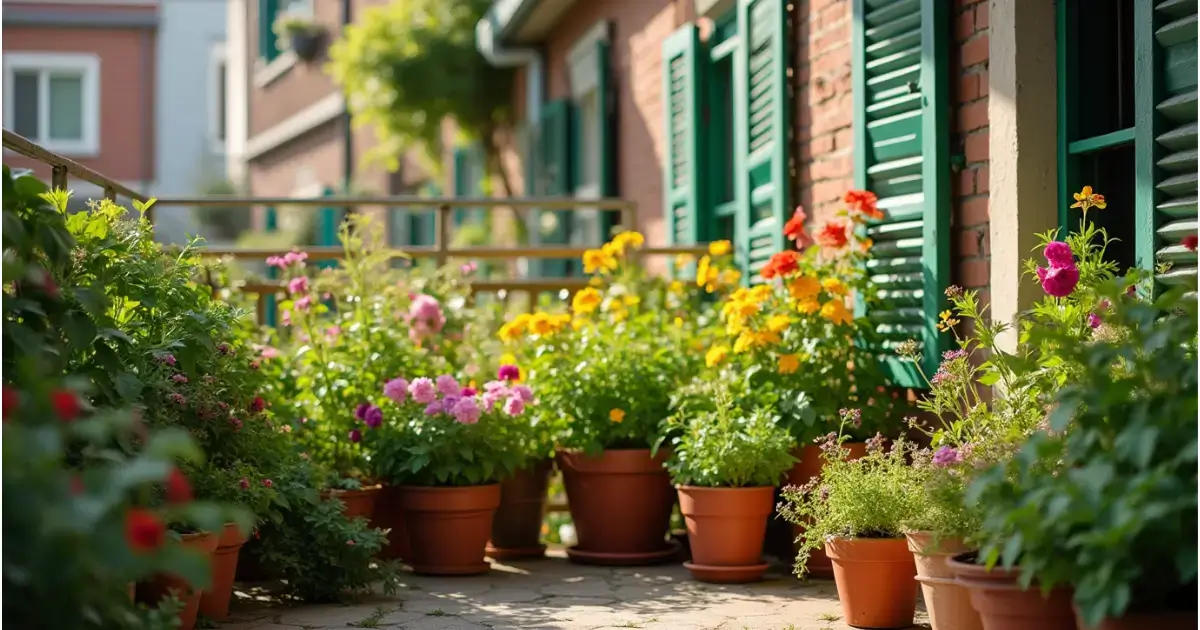Container Gardens : 5 Brilliant Ideas to Transform Any Space
Introduction : Why Container Gardens Are the Perfect Choice for Any Space ?
Container gardens are a smart and simple way to bring life, color, and even fresh food into your home without needing a big backyard. Whether you live in an apartment, have a small patio, or just want to add greenery to your windowsill, container gardening makes it possible. It’s one of the most flexible and space-saving ways to grow flowers, herbs, and vegetables.
With container gardens, you have full control over the soil, light exposure, and plant placement. You can move your pots to follow the sun or protect them from bad weather. Plus, they’re easy to start with perfect for beginners or anyone who wants a low-commitment way to enjoy gardening from home.
Even better ? You can get creative with your setup. From classic clay pots to repurposed buckets and wooden crates, your containers can be both practical and decorative. Whether you’re drawn to vibrant flower pot ideas, functional patio planter ideas, or imaginative garden planter ideas, container gardening lets you design your space to match your style and needs.
In this guide, you’ll learn everything you need to grow a thriving container garden from picking the right plants to troubleshooting common problems. Whether you’re growing fragrant herbs, fresh vegetables, or colorful blooms, this article will help you do it right while gardening from home.
In this article :
2. Understanding the Basics :
Container gardening is exactly what it sounds like growing plants in containers instead of in the ground. This method is ideal for small spaces and urban dwellers. But it also works wonderfully for adding decorative touches around larger yards.
Types of Containers :
- Plastic pots : Lightweight and affordable.
- Terracotta or clay : Breathable but dries out quickly.
- Wooden boxes : Great for rustic aesthetics.
- Ceramic : Durable and decorative.
- Grow bags : Perfect for root veggies.
- Hanging baskets and railing planters : Save floor space.
Drainage Is Key :
Always choose containers with drainage holes. Roots sitting in water cause rot. If your pot doesn’t have holes, drill them or place stones at the bottom.
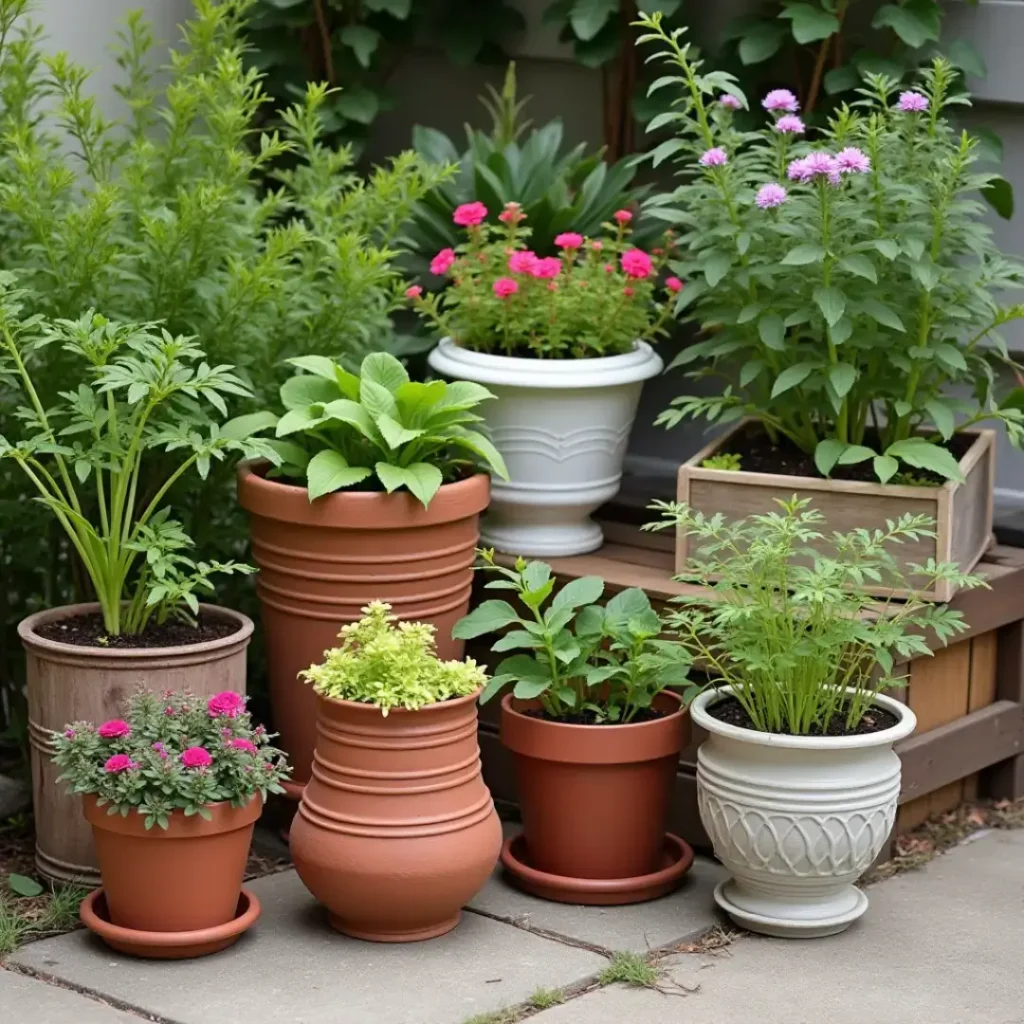
3. Choosing the Right Plants :
The right plant choice makes all the difference. Some plants love the contained space and limited soil, while others need more root room or sun.
=> 5 Great ideas & Options for Containers :
- Herbs : Basil, thyme, chives, mint, parsley.
- Vegetables : Tomatoes, lettuce, radishes, peppers.
- Flowers : Petunias, marigolds, pansies, begonias.
- Shrubs : Dwarf boxwood, lavender.
- Succulents : Aloe vera, echeveria, jade plant.
Choose plants with similar needs sunlight, watering frequency, and soil type if planting multiple in the same container.
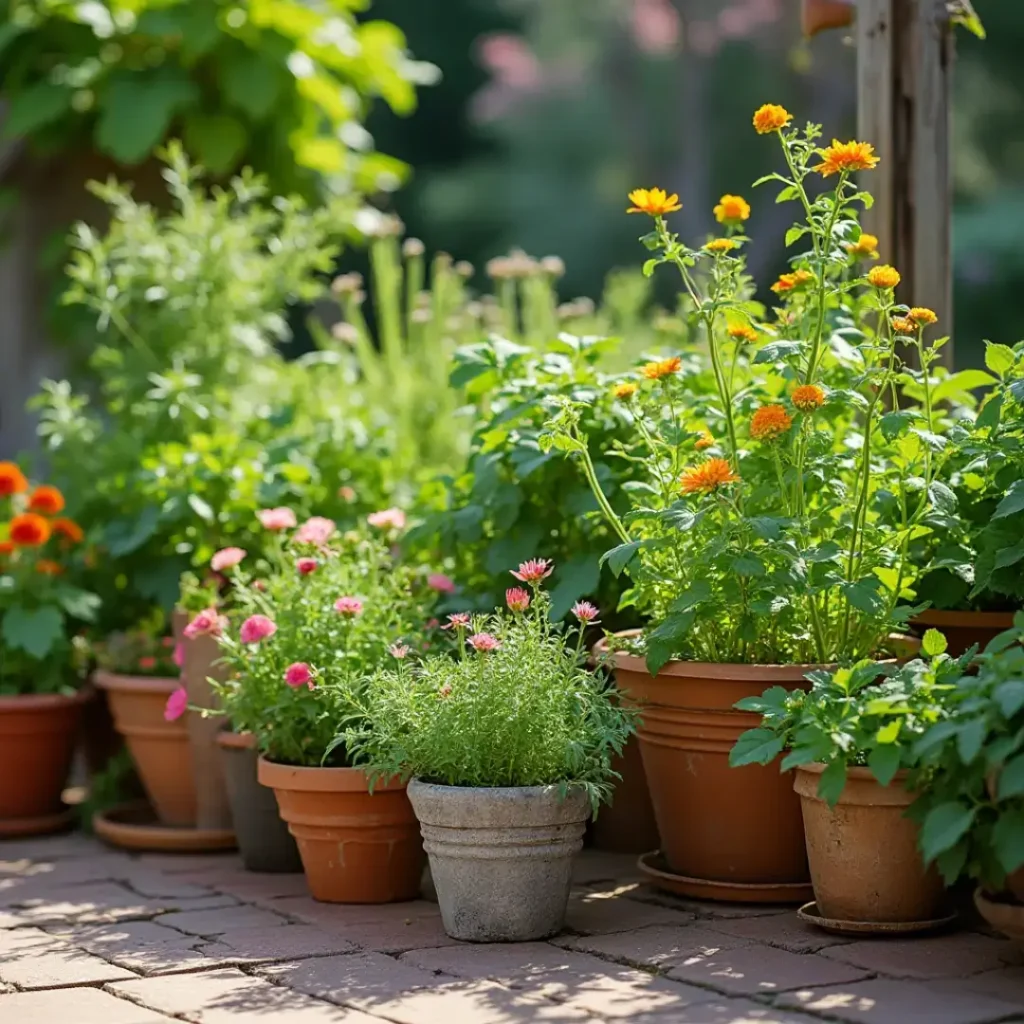
4. Planting Guide & Setup (Step-by-Step) :
Here’s how to set up your container garden correctly from scratch.
Step 1 : Pick the Right Container
Size matters. Small pots dry out fast and limit root growth. Larger pots offer more stability and moisture retention.
Step 2 : Add Drainage Layer
Use gravel or broken clay shards at the bottom if needed.
Step 3 : Use the Right Soil
Use potting mix—not garden soil. It’s light and drains well. You can also blend in compost.
Step 4 : Plant Carefully
Place taller plants in the center or back, and trailing ones near the edge. Press gently around roots, water thoroughly.
5. Essential Care & Maintenance :
Container plants need consistent care to thrive. Their limited space means less room for error.
Watering :
- Water early morning or late afternoon
- Check soil moisture daily
- Don’t let pots dry completely
Fertilizing :
Use a slow-release fertilizer or feed weekly with a liquid fertilizer diluted in water.
Sunlight & Placement :
Track how much sun your plants get daily. Rotate containers occasionally for even growth.
General Tips :
- Remove dead leaves or spent flowers
- Clean pots to avoid disease
- Re-pot as needed
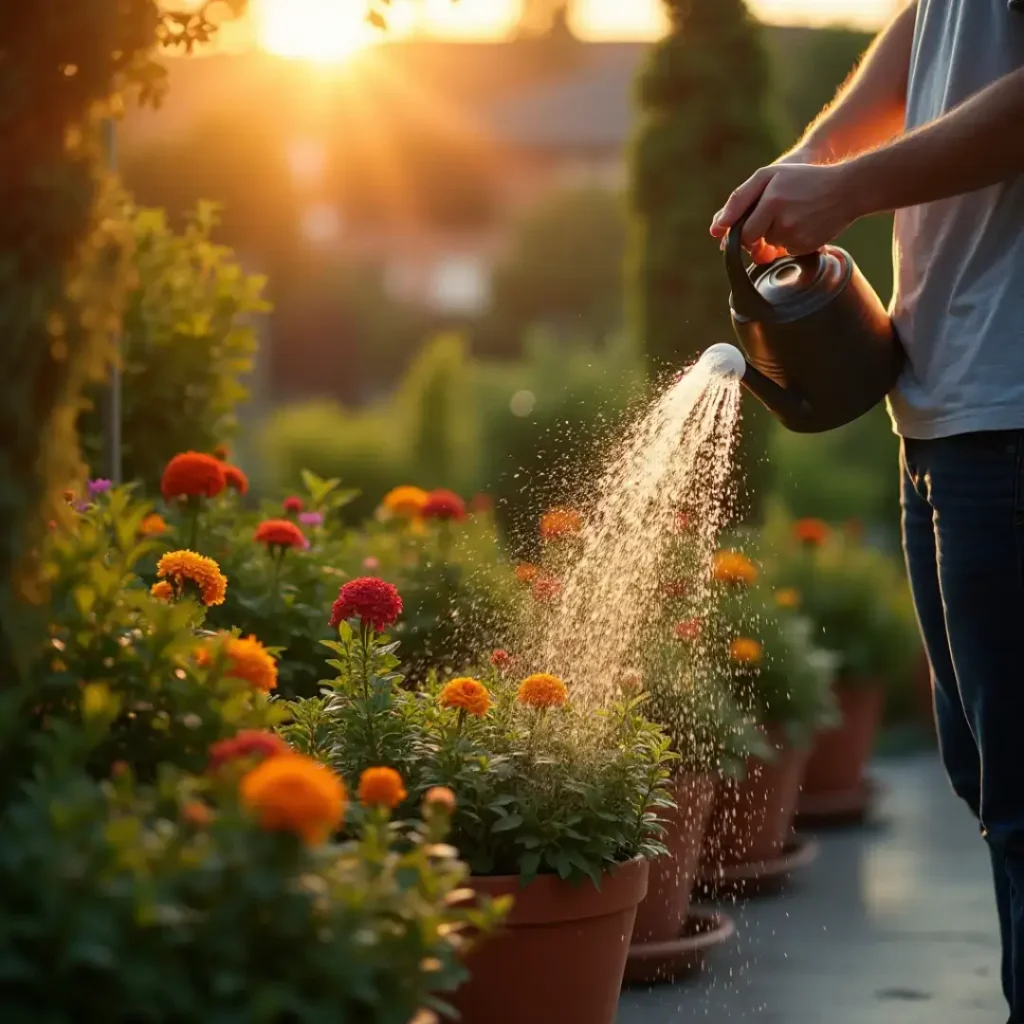
6. Common Problems & Solutions : How to Keep Your Container Garden Thriving
Even the best-kept container gardens can run into trouble. But the good news is that most issues are easy to fix once you know what to look for. Here are the most common problems that come with gardening from home in containers and exactly how to solve them.
🟡 6.1. Yellowing Leaves :
Problem : Leaves turning yellow is one of the most common signs of stress in container gardens.
Cause : Usually a result of overwatering or poor drainage. Sometimes, it’s a nutrient deficiency.
Solution :
- Check if the container has proper drainage holes.
- Let the soil dry slightly between watering.
- Add a balanced fertilizer to correct nutrient issues.
- Avoid using heavy garden soil that holds too much moisture.
🔴 6.2. Wilting Plants :
Problem : Plants suddenly droop or look lifeless.
Cause : Can be caused by underwatering, overwatering, or extreme heat.
Solution :
- Stick your finger in the soil if it’s dry past the first inch, water thoroughly.
- If the soil is soggy, improve drainage or move to a smaller watering routine.
- Shade your pots during peak heat hours or water early morning/evening.
⚫ 6.3. Root Bound Plants :
Problem : Plant roots grow in tight circles around the container edges.
Cause : The plant has outgrown its container.
Solution :
- Remove the plant and gently loosen the roots.
- Repot it into a larger container with fresh potting mix.
- Trim overly tangled roots if necessary.
⚪ 6.4. Mold or Algae on Soil :
Problem : White or green buildup on the top of the soil.
Cause : Too much moisture, poor airflow, or lack of sunlight.
Solution :
- Scrape off the moldy top layer of soil.
- Let the soil dry out before watering again.
- Improve air circulation around the plant.
- Move the container to a sunnier spot.
🔶 6.5. Fungus Gnats or Small Flying Insects :
Problem : Tiny black flies buzzing around your pots.
Cause : Overwatered soil or decaying organic matter.
Solution :
- Let the top inch of soil dry out between waterings.
- Add a thin layer of sand or diatomaceous earth on top of the soil.
- Use sticky traps or neem oil spray as a natural insect repellent.
🟣 6.6. Plants Not Blooming or Producing :
Problem : Flowering or fruiting plants fail to bloom.
Cause : Lack of nutrients, not enough sunlight, or improper pruning.
Solution :
- Use a fertilizer designed for blooming or fruiting plants.
- Make sure your container is getting the recommended hours of sunlight.
- Prune back excess growth to help the plant focus energy on blooms.
🔵 6.7. Soil Drying Too Quickly :
Problem : Water seems to disappear fast, and plants wilt in hot weather.
Cause : Small pots, poor-quality soil, or exposure to too much sun.
Solution :
- Switch to larger containers that hold moisture better.
- Use a high-quality potting mix with compost or coconut coir.
- Mulch the top layer of soil with straw, bark chips, or pebbles.
- Water more frequently during heat waves.
Bonus Tip : Rotate Your Pots
Rotate containers every few weeks to give all sides of the plant equal sunlight. This helps prevent uneven growth and reduces the chance of mold buildup.
7. Harvesting & Maximizing Your Garden’s Potential :
Container gardens aren’t just decorative—they’re productive too.
Harvesting Tips :
- Pick herbs regularly to promote growth
- Harvest veggies when ripe to avoid overgrowth
- Use scissors for clean cuts
Make the Most of Your Containers :
- Practice succession planting: replace harvested plants with new ones
- Rotate crops to refresh the soil
- Use vertical supports for climbing plants like beans or cherry tomatoes
8. Final Thoughts & Call to Action
Container gardens are flexible, affordable, and incredibly satisfying. From enhancing your patio’s beauty to supplying fresh herbs for dinner, they’re a great step into gardening for everyone.
So whether you’re growing lavender in a clay pot or basil in a coffee can, take a moment today to start your own little garden. With the tips in this guide, you’re ready to grow something beautiful.
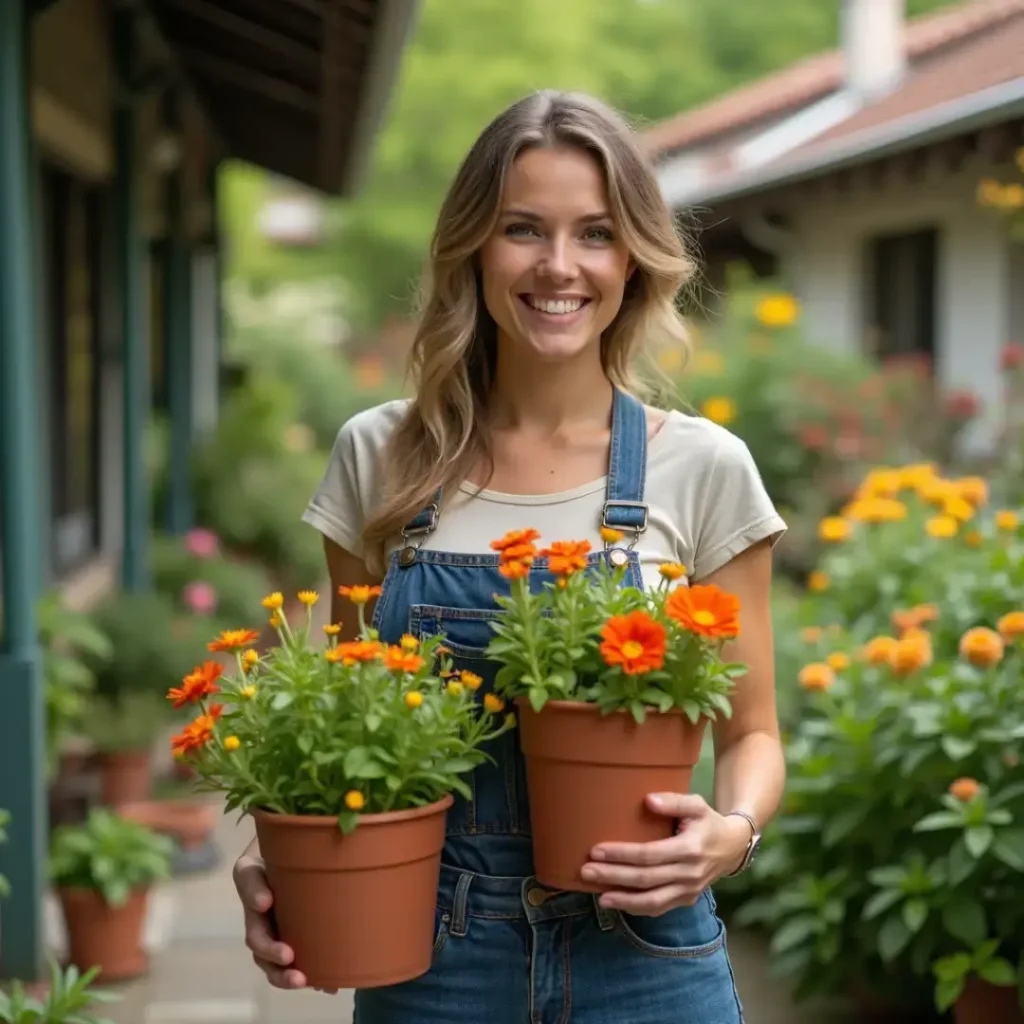
9. Conclusion : Grow More with Less Using Container Gardens
Container gardens prove that you don’t need a large plot of land or even a backyard to grow something beautiful and useful. With the right containers, good soil, and a few well-chosen plants, you can enjoy gardening from home no matter where you live.
This simple method makes growing herbs, flowers, or vegetables accessible to everyone. You’re not just saving space you’re gaining control, convenience, and creative freedom. Whether you want to brighten up your balcony, add life to your patio, or grow fresh ingredients by your kitchen window, container gardening gives you the tools to make it happen.
The best part ? It’s easy to get started and easy to keep going. With just a little daily care, your containers will reward you with color, fragrance, and even food all while turning your home into a greener, more joyful space.
So, grab a pot, pick a plant, and start your container garden today. Your growing journey doesn’t have to start in a field. It starts right where you are.
❓ FAQs : Container Gardens
1. What are the best vegetables to grow in containers ?
Some of the easiest and most rewarding vegetables to grow in containers include tomatoes, lettuce, peppers, radishes, and green beans. They don’t require much space and adapt well to pots.
2. How often should I water my container garden ?
Most container plants need watering once a day in warm weather and less in cooler seasons. Always check the top inch of soil—if it’s dry, it’s time to water.
3. What size pot should I use for herbs or vegetables ?
For herbs, 6–8 inch pots are usually enough. For vegetables like tomatoes or peppers, go for a container that’s at least 12–18 inches deep and wide.
4. Can I grow flowers and vegetables together in the same container?
Yes, you can—as long as the plants have similar light, water, and soil needs. For example, marigolds grow well with tomatoes and also help repel pests.
5. What’s the best soil for container gardens ?
Use a high-quality potting mix, not garden soil. Look for soil that’s light, drains well, and includes compost or organic matter. Adding perlite or vermiculite can improve drainage.
6. How do I prevent pests in my container garden ?
Inspect your plants often. Use natural remedies like neem oil or insecticidal soap. Avoid overwatering, which can invite fungus gnats. Keep leaves clean and remove dead foliage.
7. Why do my plants look healthy but aren’t flowering ?
This could be due to lack of sunlight or nutrients. Make sure flowering plants get at least 6 hours of sunlight and feed them with a bloom-boosting fertilizer.
8. Can I keep container plants outside year-round ?
It depends on your climate. In cold regions, some containers may crack, and plants may freeze. Move pots indoors or choose cold-hardy plants and frost-resistant containers for year-round outdoor gardening.

